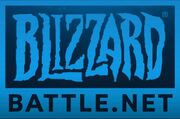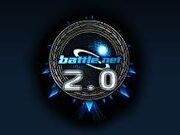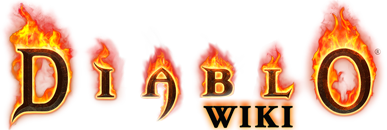
Current Battle.net logo
Battle.net is Blizzard's online match-making component for several of their game franchises. The network features both PvP and co-op play.
Battle.net is supported for Diablo, StarCraft, Diablo II, WarCraft II Battle.net Edition, WarCraft III, StarCraft II and Diablo III including expansions, except the Hellfire expansion for Diablo I. The network got a complete overhaul with the release of StarCraft II.
Original Battle.net[]

Original Battle.net logo
Diablo[]
When the service initially launched with Diablo in December 1996, Battle.net offered only a few basic services like chatting and game listings. Players could connect to the service, talk with other gamers and join multiplayer games of Diablo. Besides user account data, no game data was stored on the Battle.net servers. When a player connected to a game, they would be connecting directly to the other players in the game. No data was sent through the Battle.net servers. While this made the service quick and easy to use, it quickly led to rampant cheating since players using cheats could modify their game data locally. However, since there was an option to create private games, many players ended up playing with people whom they knew.
Hellfire[]
Hellfire did not have any kind of multiplayer options, except those added by editing the Command.txt file.
Diablo II[]
The main highlight of Diablo II as it relates to Battle.net was that the game was completely client-server based. The game was no longer simulated on each player's computer, but instead was run on Blizzard's server. This also meant that all of the character data for the game was stored on the Battle.net servers. This effectively put an end to cheating. The game also had an open character feature on Battle.net which stored the player's character on the client. This allowed players to play characters locally or on a LAN, and then use those same characters on Battle.net. However, any open games played on Battle.net were not protected from cheating by other players since they could have modified their characters locally. Diablo II also had a unique feature that would show the players in the Battle.net chat room as avatars who looked like their characters did in the game. It also used a different Battle.net interface than previous games, where previously there were mainly only color differences. There was also expanded ladder support including a "Hardcore" ladder which listed players whose characters would be removed permanently if they died in-game.
Diablo II: Lord of Destruction[]
With the release of the expansion, the usage of Battle.net rose dramatically.
Forums[]
The actual website (as opposed to the game servers) had several Battle.net Forums[1] Although the focus was mostly on Starcraft it had three features related to Diablo:
- the Diablo Strategy Forum was up 9 pages by June 1997[2]
- the Diablo Clan Hall was up to 5 pages by September 1999[3]
- Diablo II Suggestions was up to 20 pages by August 1999[4]
- Hardcore Strategy and Tactics was up to 19 pages by April 2001[5]
Battle.net 2.0[]

Battle.net 2.0 logo
- A new version of battle.net launched on March 19, 2009. A preview page was opened in February 2010.
- The project director of the new battle.net is Greg Canessa.
- The new battle.net is expected to support all new Blizzard games.
Supported Games[]
The following Blizzard games are currently supported on Battle.net:
- StarCraft series: StarCraft • StarCraft: Brood War • StarCraft II: Wings of Liberty • StarCraft II: Heart of the Swarm • StarCraft II: Legacy of the Void
- Warcraft series: Warcraft II: Battle.net Edition • Warcraft III: Reign of Chaos • Warcraft III: The Frozen Throne • World of Warcraft • World of Warcraft: The Burning Crusade • World of Warcraft: Wrath of the Lich King • World of Warcraft: Cataclysm • World of Warcraft: Mists of Pandaria • World of Warcraft: Warlords of Draenor • World of Warcraft: Legion
- Diablo series: Diablo • Diablo II • Diablo II: Lord of Destruction • Diablo III • Diablo III: Reaper of Souls
- Overwatch
The following future Blizzard games will be supported on Battle.net:
- StarCraft series:
- Warcraft series:
- Diablo series:
The following older Blizzard games do not support Battle.net:
- Warcraft series: Warcraft: Orcs & Humans • Warcraft II: Tides of Darkness • Warcraft II: Beyond the Dark Portal
- Diablo series: Diablo: Hellfire
Diablo III[]
Beginning with Diablo III, all Diablo games are hosted on Battle.net and require connecting to it to play. This follows the trend of other Blizzard games and the industry as a whole. It is still possible to create private games for solo play, but they do require an internet connection regardless.
External links[]
- http://www.battle.net
- Battle.net 2.0 - The Next Generation Gaming Network
- Definite Battle.net 2.0 Features
- ↑ https://web.archive.org/web/19990420031651/http://battle.net/forums.shtml
- ↑ https://web.archive.org/web/19970612080659/http://www.battle.net/forums/diablo-strategy/index.htm
- ↑ https://web.archive.org/web/19990902223459/http://battle.net/forums/diablo-clans/
- ↑ https://web.archive.org/web/19990829054900/http://www.battle.net/forums/diablo2-suggestions/
- ↑ https://web.archive.org/web/20010416235044/http://www.battle.net/forums/diablo2-hardcore/
